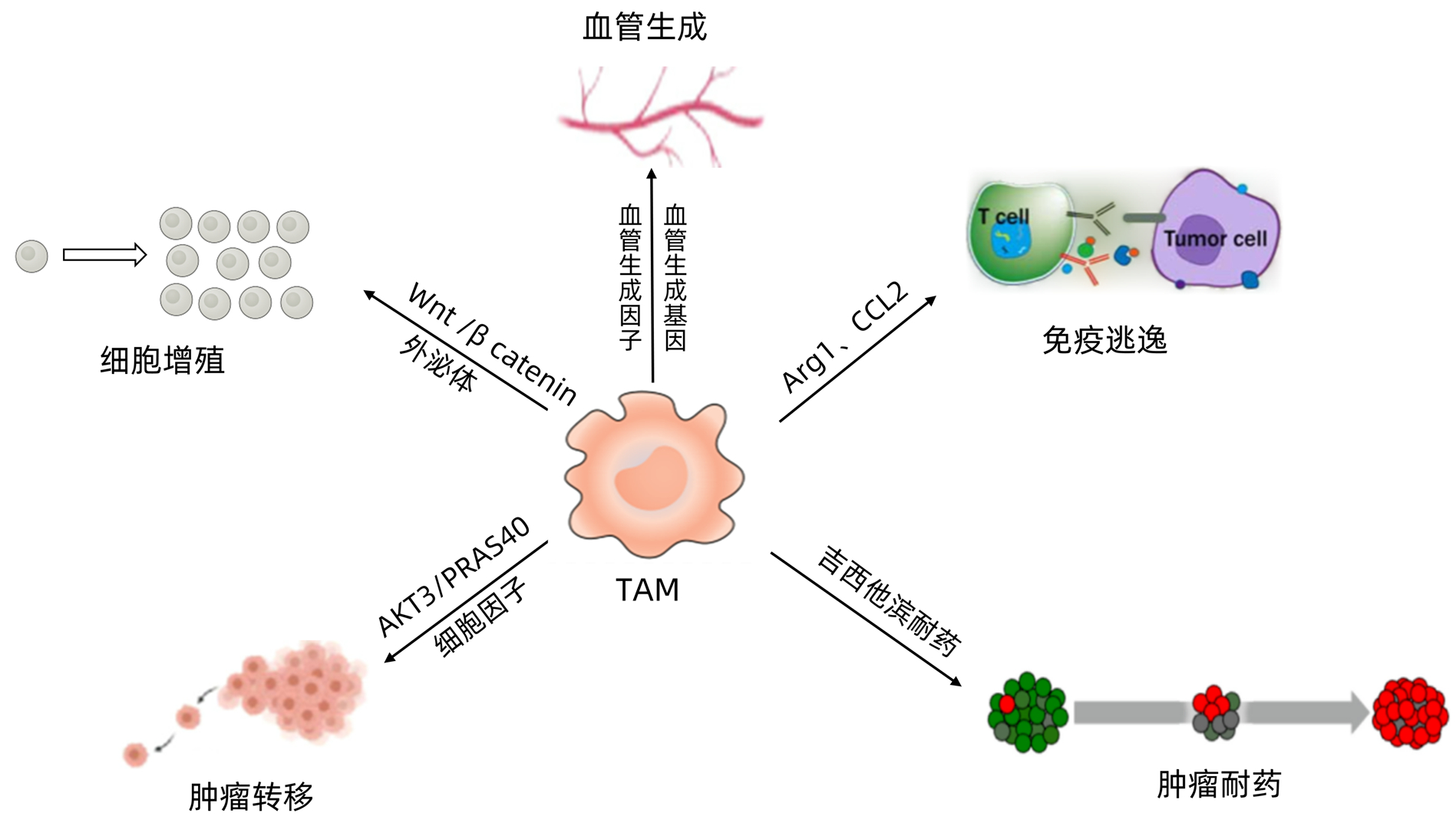肿瘤相关巨噬细胞在胆管细胞癌中的作用
DOI: 10.3969/j.issn.1001-5256.2023.02.035
利益冲突声明:所有作者均声明不存在利益冲突。
作者贡献声明:韩品盛负责文献查阅,论文撰写;杨龙、崔涛负责论文修改,研究指导;张雅敏负责研究指导,经费支持。
-
摘要: 胆管细胞癌(CCA)是一种恶性程度高,侵袭性强,预后极差,且对放化疗不敏感的胆道恶性肿瘤。肿瘤相关巨噬细胞(TAM)是肿瘤微环境中的重要组成部分,CCA细胞通过释放细胞因子的方式,将TAM募集到肿瘤组织中,并将其极化为M2型TAM,并通过辅助免疫逃逸、促进肿瘤细胞增殖、调控血管生成、促进肿瘤转移、介导免疫耐药等多种机制促进CCA进展。TAM作为一种肿瘤免疫治疗的新兴靶点为CCA的靶向治疗提供了新思路。本文将对近年来TAM促进CCA进展的机制和靶向TAM的免疫治疗作一综述。Abstract: Cholangiocarcinoma (CCA) is a highly malignant biliary tumor with strong invasion and poor prognosis and is insensitive to radiotherapy and chemotherapy. Tumor-associated macrophage (TAM) is an important component of the tumor microenvironment. CCA cells recruit TAM into tumor tissue by releasing cytokines and polarize them into M2 TAM, which promotes the progression of CCA through various mechanisms such as assisting immune escape, promoting tumor cell proliferation, regulating angiogenesis, promoting tumor metastasis, and mediating immune resistance. As an emerging target of tumor immunotherapy, TAM provides new ideas for targeted therapy for CCA. This article reviews the mechanisms of TAM in promoting the progression of CCA and immunotherapy targeting TAM in recent years.
-
Key words:
- Bile Duct Neoplasms /
- Macrophages /
- Tumor Microenvironment
-
[1] BERTUCCIO P, MALVEZZI M, CARIOLI G, et al. Global trends in mortality from intrahepatic and extrahepatic cholangiocarcinoma[J]. J Hepatol, 2019, 71(1): 104-114. DOI: 10.1016/j.jhep.2019.03.013. [2] VALLE J, WASAN H, PALMER DH, et al. Cisplatin plus gemcitabine versus gemcitabine for biliary tract cancer[J]. N Engl J Med, 2010, 362(14): 1273-1281. DOI: 10.1056/NEJMoa0908721. [3] CASSETTA L, POLLARD JW. Tumor-associated macrophages[J]. Curr Biol, 2020, 30(6): R246-R248. DOI: 10.1016/j.cub.2020.01.031. [4] MURRAY PJ. Macrophage polarization[J]. Annu Rev Physiol, 2017, 79: 541-566. DOI: 10.1146/annurev-physiol-022516-034339. [5] RHEE I. Diverse macrophages polarization in tumor microenvironment[J]. Arch Pharm Res, 2016, 39(11): 1588-1596. DOI: 10.1007/s12272-016-0820-y. [6] ZHOU M, WANG C, LU S, et al. Tumor-associated macrophages in cholangiocarcinoma: complex interplay and potential therapeutic target[J]. EBio Medicine, 2021, 67: 103375. DOI: 10.1016/j.ebiom.2021.103375. [7] RAGGI C, CORRENTI M, SICA A, et al. Cholangiocarcinoma stem-like subset shapes tumor-initiating niche by educating associated macrophages[J]. J Hepatol, 2017, 66(1): 102-115. DOI: 10.1016/j.jhep.2016.08.012. [8] TRIPATHI C, TEWARI BN, KANCHAN RK, et al. Macrophages are recruited to hypoxic tumor areas and acquire a pro-angiogenic M2-polarized phenotype via hypoxic cancer cell derived cytokines Oncostatin M and Eotaxin[J]. Oncotarget, 2014, 5(14): 5350-5368. DOI: 10.18632/oncotarget.2110. [9] CHEN X, SONG E. Turning foes to friends: targeting cancer-associated fibroblasts[J]. Nat Rev Drug Discov, 2019, 18(2): 99-115. DOI: 10.1038/s41573-018-0004-1. [10] ZIANI L, CHOUAIB S, THIERY J. Alteration of the antitumor immune response by cancer-associated fibroblasts[J]. Front Immunol, 2018, 9: 414. DOI: 10.3389/fimmu.2018.00414. [11] LEONE RD, POWELL JD. Metabolism of immune cells in cancer[J]. Nat Rev Cancer, 2020, 20(9): 516-531. DOI: 10.1038/s41568-020-0273-y. [12] HAYES CS, SHICORA AC, KEOUGH MP, et al. Polyamine-blocking therapy reverses immunosuppression in the tumor microenvironment[J]. Cancer Immunol Res, 2014, 2(3): 274-285. DOI: 10.1158/2326-6066.CIR-13-0120-T. [13] WHITESIDE TL. What are regulatory T cells (Treg) regulating in cancer and why?[J]. Semin Cancer Biol, 2012, 22(4): 327-334. DOI: 10.1016/j.semcancer.2012.03.004. [14] VIVIER E, UGOLINI S, BLAISE D, et al. Targeting natural killer cells and natural killer T cells in cancer[J]. Nat Rev Immunol, 2012, 12(4): 239-252. DOI: 10.1038/nri3174. [15] HASITA H, KOMOHARA Y, OKABE H, et al. Significance of alternatively activated macrophages in patients with intrahepatic cholangiocarcinoma[J]. Cancer Sci, 2010, 101(8): 1913-1919. DOI: 10.1111/j.1349-7006.2010.01614.x. [16] PERUGORRIA MJ, OLAIZOLA P, LABIANO I, et al. Wnt-β-catenin signalling in liver development, health and disease[J]. Nat Rev Gastroenterol Hepatol, 2019, 16(2): 121-136. DOI: 10.1038/s41575-018-0075-9. [17] LOILOME W, BUNGKANJANA P, TECHASEN A, et al. Activated macrophages promote Wnt/β-catenin signaling in cholangiocarcinoma cells[J]. Tumour Biol, 2014, 35(6): 5357-5367. DOI: 10.1007/s13277-014-1698-2. [18] BOULTER L, GUEST RV, KENDALL TJ, et al. WNT signaling drives cholangiocarcinoma growth and can be pharmacologically inhibited[J]. J Clin Invest, 2015, 125(3): 1269-1285. DOI: 10.1172/JCI76452. [19] CHEN S, CHEN Z, LI Z, et al. Tumor-associated macrophages promote cholangiocarcinoma progression via exosomal Circ_0020256[J]. Cell Death Dis, 2022, 13(1): 94. DOI: 10.1038/s41419-022-04534-0. [20] SUBIMERB C, PINLAOR S, LULITANOND V, et al. Circulating CD14(+) CD16(+) monocyte levels predict tissue invasive character of cholangiocarcinoma[J]. Clin Exp Immunol, 2010, 161(3): 471-479. DOI: 10.1111/j.1365-2249.2010.04200.x. [21] HENZE AT, MAZZONE M. The impact of hypoxia on tumor-associated macrophages[J]. J Clin Invest, 2016, 126(10): 3672-3679. DOI: 10.1172/JCI84427. [22] SUN D, LUO T, DONG P, et al. M2-polarized tumor-associated macrophages promote epithelial-mesenchymal transition via activation of the AKT3/PRAS40 signaling pathway in intrahepatic cholangiocarcinoma[J]. J Cell Biochem, 2020, 121(4): 2828-2838. DOI: 10.1002/jcb.29514. [23] TECHASEN A, LOILOME W, NAMWAT N, et al. Cytokines released from activated human macrophages induce epithelial mesenchymal transition markers of cholangiocarcinoma cells[J]. Asian Pac J Cancer Prev, 2012, 13(Suppl): 115-118. [24] KITANO Y, OKABE H, YAMASHITA YI, et al. Tumour-infiltrating inflammatory and immune cells in patients with extrahepatic cholangiocarcinoma[J]. Br J Cancer, 2018, 118(2): 171-180. DOI: 10.1038/bjc.2017.401. [25] SICA A, LARGHI P, MANCINO A, et al. Macrophage polarization in tumour progression[J]. Semin Cancer Biol, 2008, 18(5): 349-355. DOI: 10.1016/j.semcancer.2008.03.004. [26] EL-GAMAL MI, AL-AMEEN SK, AL-KOUMI DM, et al. Recent advances of colony-stimulating factor-1 receptor (CSF-1R) kinase and its inhibitors[J]. J Med Chem, 2018, 61(13): 5450-5466. DOI: 10.1021/acs.jmedchem.7b00873. [27] MACDONALD KP, PALMER JS, CRONAU S, et al. An antibody against the colony-stimulating factor 1 receptor depletes the resident subset of monocytes and tissue- and tumor-associated macrophages but does not inhibit inflammation[J]. Blood, 2010, 116(19): 3955-3963. DOI: 10.1182/blood-2010-02-266296. [28] PYONTECK SM, AKKARI L, SCHUHMACHER AJ, et al. CSF-1R inhibition alters macrophage polarization and blocks glioma progression[J]. Nat Med, 2013, 19(10): 1264-1272. DOI: 10.1038/nm.3337. [29] YOSHIMURA T. The chemokine MCP-1 (CCL2) in the host interaction with cancer: a foe or ally?[J]. Cell Mol Immunol, 2018, 15(4): 335-345. DOI: 10.1038/cmi.2017.135. [30] DWYER BJ, JARMAN EJ, GOGOI-TIWARI J, et al. TWEAK/Fn14 signalling promotes cholangiocarcinoma niche formation and progression[J]. J Hepatol, 2021, 74(4): 860-872. DOI: 10.1016/j.jhep.2020.11.018. [31] LOGTENBERG M, SCHEEREN FA, SCHUMACHER TN. The CD47-SIRPα immune checkpoint[J]. Immunity, 2020, 52(5): 742-752. DOI: 10.1016/j.immuni.2020.04.011. [32] VAETEEWOOTTACHARN K, KARIYA R, POTHIPAN P, et al. Attenuation of CD47-SIRPα signal in cholangiocarcinoma potentiates tumor-associated macrophage-mediated phagocytosis and suppresses intrahepatic metastasis[J]. Transl Oncol, 2019, 12(2): 217-225. DOI: 10.1016/j.tranon.2018.10.007. [33] SHARPE AH, PAUKEN KE. The diverse functions of the PD1 inhibitory pathway[J]. Nat Rev Immunol, 2018, 18(3): 153-167. DOI: 10.1038/nri.2017.108. [34] LOEUILLARD E, YANG J, BUCKARMA E, et al. Targeting tumor-associated macrophages and granulocytic myeloid-derived suppressor cells augments PD-1 blockade in cholangiocarcinoma[J]. J Clin Invest, 2020, 130(10): 5380-5396. DOI: 10.1172/JCI137110. -



 PDF下载 ( 2014 KB)
PDF下载 ( 2014 KB)


 下载:
下载:


